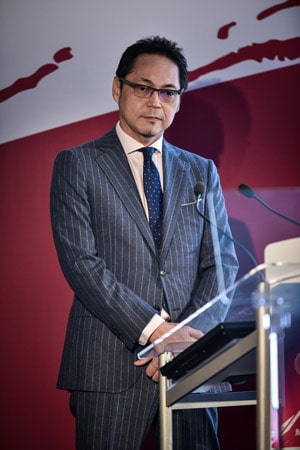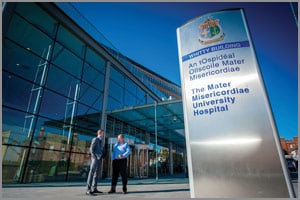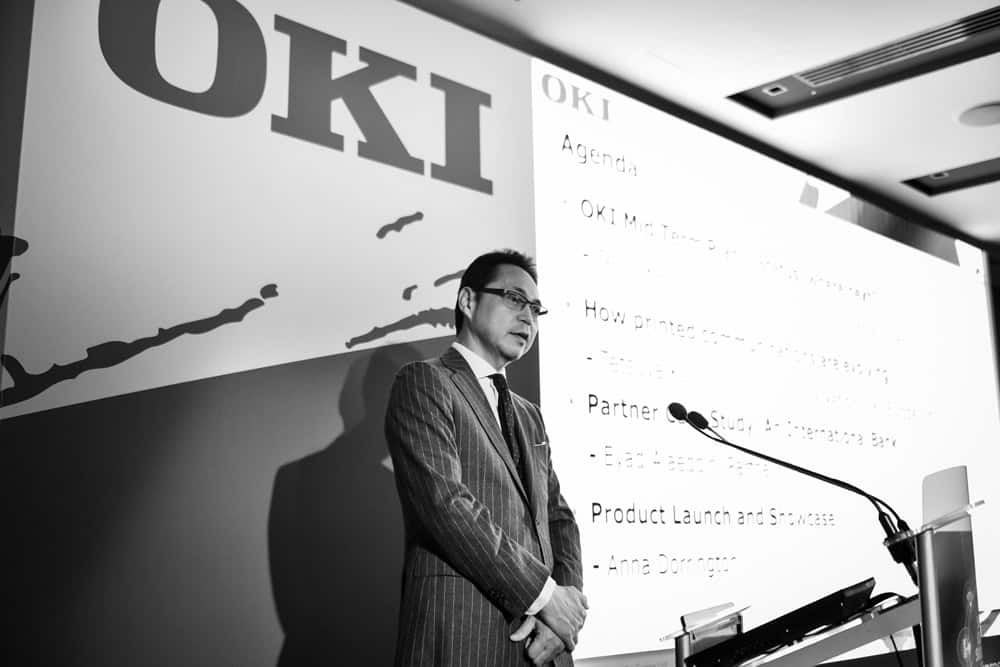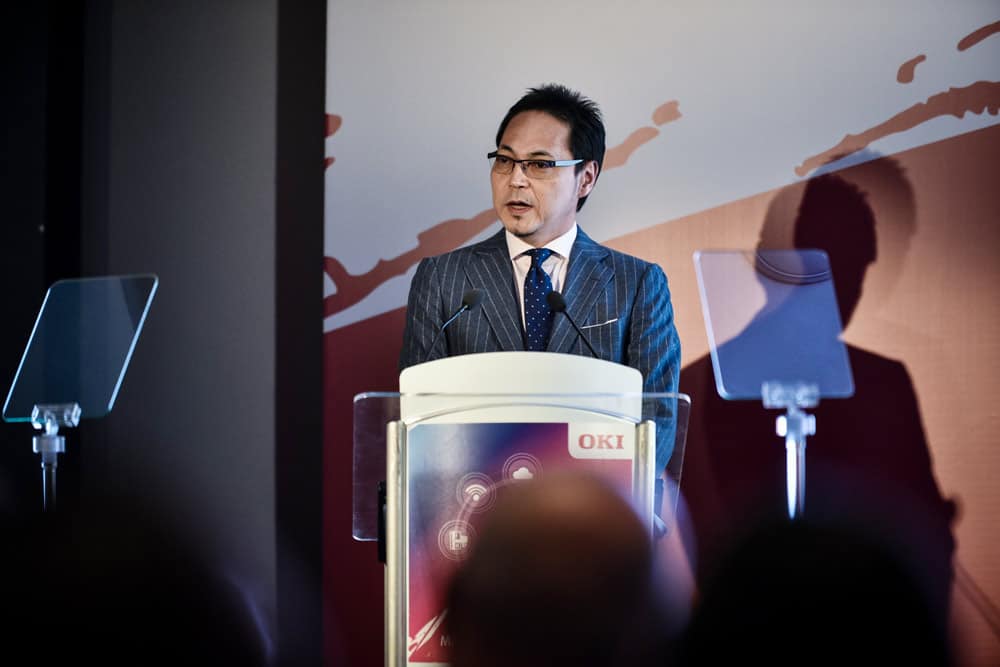OKI Europe managing director Terry Kawashima speaks at the OKI Smart Colour Solutions event in Milan last October
Colin White speaks with Terry Kawashima about how OKI hopes to transform the way printers are used within businesses of every size.
Q. How has the print industry evolved since you first became involved with OKI 30 years ago?
The one obvious big difference between now and 30 years ago is in terms of the geography of markets. Before technology became part of our everyday life it was more divided.
When I first came to Europe we’d discuss budgets every January. I think as much as 30% of these meetings were focused on how to find customers outside the national border to increase profitable exports. Europe has changed massively since then.
The internet has provided an important opportunity to learn from other countries. For me, the European geographic differences are very interesting. Culture, mentality and customs: these things make a difference and of course when we are talking about the different vertical industries that we focus on there are always different characteristics.
Q. Why has healthcare become a bigger focus for OKI?
Healthcare is an interesting market. Transporting one success in one country to another in the healthcare industry is not that easy.
Three and a half years ago, we decided that healthcare was one industry to focus on. We have experience in all of the industries we focus on: retail, graphic art and healthcare. We picked these due to our experience and knowledge.
But, in short, we found that printing is still in heavy use within the healthcare sector. It’s important to the workflow and as a result print volumes are very high. So, we’ve targeted print centric industries, where print is vital to everyday workflow.
However, we’ve had a steeper learning curve in regard to healthcare than the retail or graphic art sectors. OKI printers can be integrated and can add value to an end customer in a healthcare environment. And it is key that we have the right protocols and education in healthcare, continuing to stress our focus in that environment. Jonathan Millbank, our healthcare general manager, is helping us tremendously with that.
Q. Is the print industry still relevant as we move into an increasingly digital world?
Print is such a massive industry. Analogue print is not dead technology; it’s a huge market, and I think companies who have digital print technologies are enjoying identifying new applications to take from analogue print. Looking at value, what digital print technologies can charge over analogue is much less than the add value.
… we are giving opportunities to smaller businesses to be able to have efficient solutions in their workflow
Although digital technology has obviously taken over some of the print application, this analogue print market is so large it will not disappear. I’m 100% convinced that print is not becoming a small industry and as an innovative company I think we will see growing opportunities due to our focus on applications and solutions.
Q. How important is the customer experience?
We are learning from experience. The touch panel on the single function printer is one example of how we are increasing the ease of use for the customer.
We have learned that some customers do not enjoy too many functionalities, and I think with a tailored touch panel configuration you can actually successfully guide the end user. For example, clerks in a retail shop just have to press one button and can print straight away with OKI’s products. This is really vital, especially coming to the area of those vertical solutions where print by itself is only one part of the workflow.
We have a systematic approach to improve the user experience. We continue to learn what customers really want and will pay for. Using the example of retail, the management people in retail companies don’t want clerks wasting time, struggling with printers. The most important aspect is the ease of operation and a situation where no time is wasted.
Q. Is it fair to say OKI is targeting more small companies with today’s product announcement?
The platform we are demonstrating today is designed to be able to address a broader range of customers, including smaller businesses. With our new range, it’s easy to customise panels and the Sendys Explorer ‘lite’ system is available free from our website.
Sendys Explorer enables the user to convert documents and distribute or upload to a chosen location, providing greater flexibility to edit, access, print, retrieve and share files. Users of our products will be able to entertain a level of solutions not available from our competitors and I think with the platform on offer we are giving opportunities to smaller businesses to be able to have efficient solutions in their workflow.
However, the products are not only targeted at small businesses. In fact, with customers today what’s important is a stable, high-quality product. As far as we are concerned we have a very high level of media facilities and many of our customers – especially those who target verticals – appreciate that.
Q. How much of a focus has been placed on increasing security in the new range announced today?
I think security is a major concern for any business, large or small. In our experience we have seen how security is such an important policy within large corporations. However, smaller companies need more assistance with security features and what our senior product marketing manager Anna Emilia Dorrington presented and demonstrated in our showcase is going to help our smaller businesses to easily increase this level of security.

Terry Kawashima
Q. What is the one element you want people to take away from today’s launch and what future advancements is OKI looking towards?
OKI is increasingly focusing on professional print and office solutions. I’m talking about two different fields here, but there is a certain overlap with the two. Take retail for example: a lot of retail end customers actually prefer to buy what we call graphic art printers.
In that sort of environment we are seeing huge opportunities and we now have in our portfolio wide format printing technology, which really helps us to increasingly understand the needs of the customers in that sort of environment.
I really see opportunities to expand with LED technology into more industrial applications, such as labelling for example. LED is so flexible and I think we have a big opportunity in that field. All in all I am extremely optimistic that we are able to actually accelerate our journey into this area of industry print.
Business & Finance spoke with Terry Kawashima at the OKI Smart Colour Solutions event in Milan in October. For more information about OKI Europe’s new range of colour and multifunction printers: w: oki.com/ie/printing
CASE STUDY: MATER HOSPITAL
The healthcare industry is becoming increasingly complex, with providers being asked to deliver quality care, ensure patient safety and improve operations at a time when budgets are under pressure.
To meet these challenges, healthcare organisations, including hospitals, laboratories and pharmacies, require integrated, patient-centric solutions to improve business processes and overcome key challenges.
The Mater Misericordiae University Hospital holds a unique place in the delivery of healthcare in Dublin. Like most modern hospitals the Mater has an extensive ICT network where hospital management is constantly looking at ways to reduce costs and improve efficiencies.
A Lean Six Sigma programme identified printing as an area where savings could be achieved. The project team engaged with OKI as the hospital’s print partner to gather evidence-based information on the precise current printing solution across the campus.
As a result of this process the true cost of printing was now understood. The next step in the engagement with OKI was a considered proposal where OKI would provide a managed service for the printing requirements identified in the audit.
 The proposal included a complete refresh of non-performing or non-economically viable printers and a consolidation of printers and model types.
The proposal included a complete refresh of non-performing or non-economically viable printers and a consolidation of printers and model types.
In addition the ‘PrintFleet’ software tool allows remote management of consumables via email alerts and facilitates the complete management of all print devices.
The proposal also included the ongoing maintenance of the printers in conjunction with the Mater ICT department. In a hospital environment maintaining services is critical and the project rollout had to reflect this requirement in a live environment, fully conscious of the nature of the service that was being provided. To minimise disruption to public and staff a phased approach to the rollout was undertaken at locations and times that facilitated ongoing hospital workflow.
Since 2012 the Mater in conjunction with OKI as printing partner has achieved the following:
- Consolidated the number of print devices by 20% and the number of model types by 60%
- Fully optimised the consumable management with no waste
- Introduced multi-function devices where appropriate
- Raised user awareness of printing costs
- Refreshed the fleet of print devices
- Reduced expensive colour printing by 75%






